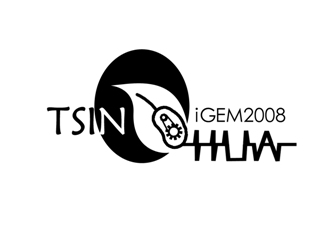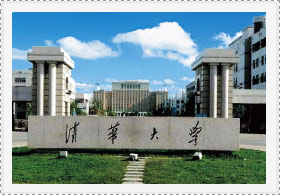Team:Tsinghua
From 2008.igem.org
Ylzouyilong (Talk | contribs) |
Ylzouyilong (Talk | contribs) (→Intro of Our Project) |
||
| Line 16: | Line 16: | ||
{|align="justify" | {|align="justify" | ||
| - | | | + | |our project |
| - | + | ||
| - | + | ||
| - | + | ||
| - | + | ||
| - | + | ||
|[[image:Thu_Logo.jpg|right]] | |[[image:Thu_Logo.jpg|right]] | ||
|} | |} | ||
Revision as of 09:40, 26 October 2008
| HOME | Team | Project | Parts | Modelling | Notebook | Doodle Board |
|---|
Contents |
Intro of Our Project
| our project |
News
GF taq is recommended in our PCR reactions. 2008.June.25
The first plasmid is successfully constrcuted. 2008.Jul.20
The gene we need is at synthesis in Geneart. 2008.Jul.24
The standard vector pSB1A3 lost in the transformation. 2008.Jul.28
Then it finally succeeds. 2008.Jul.31
Template of one of the receptors are still in vacancy.
New edition of project interpretation are in process.
Intro of Tsinghua University
| Tsinghua University was established in 1911, originally under the name “Tsinghua Xuetang”. The school was renamed "Tsinghua School" in 1912. The university section was founded in 1925. The name “National Tsinghua University” was adopted in 1928.click here to see more pictures
The educational philosophy of Tsinghua is to "train students with integrity." Among over 120,000 students who have graduated from Tsinghua since its founding are many outstanding scholars, eminent entrepreneurs and great statesmen remembered and respected by their fellow Chinese citizens. With the motto of “Self-Discipline and Social Commitment” and the spirit of “Actions Speak Louder than Words”, Tsinghua University is dedicated to the well-being of Chinese society and to world development. |
== Our Schedule ==
Time Events
Dec. 15, 2007 Team of Tsinghua University Founded
Dec. 31, 2007 Brain Storm(1)
Jan-Feb, 2008 Backgroud Investigation
Feb.25, 2008 Brain Storm(2)
Mar., 2008 Experimental procedure design;
Modeling in silico Started
Apr.1,2008 Wet Lab work started
Apr.-Aug.,2008 Wet Lab Work
May.1, 2008 Team Registry
May.25, 2008 Students’ Association of Synthetic Biology(SASB) Founded
June.21, 2008 “Teach the teacher “workshop, in Kyoto, Japan
Sept.-Oct., 2008 Inspection and Revision
Oct.20,2008 Summary, Presentation Preparation
Nov.8-9,2008 Jamboree In MIT
== Abstract ==
This year we are trying to work at the motility of bacteria. E.coli senses some chemicals and moves toward
or stays still, this behavior is called chemotaxis. Any modification of the pathway from the sensor to the motile apparatus will cause into different chemotactic effcts.
Moreover,most of the biosensors today are designed for a specific target signal, and they can not
substitute each other in most cases. By structural analysis we find that most receptors for the same type of ligands exhibits great similarity, both in sequence information and characteristics. Our project
is designed toward an "Interchangeable Biosensor". The strategy is almost trial and error, to find
an appropriate pathway between chemical molecules and corresponding reactions. Signals other than
chemicals are much harder to manipulate, and to integrate together the signals seems even more
challenging,we are trying to isolate the elements and standardise them.
== Background ==
Motile bacteria can respond to chemical gradients in their environment. Such directed movement in response to special chemicals is defined as chemotaxis. If organisms detect substances beneficial for surviving, positive chemotaxis occurs and cells will move in the direction of increasing concentration. In contrast, negative chemotaxis occurs when motile bacteria move away from a repellant. Both kinds of responses adjust the behaviors of organisms to the environment, thus improve their ability of surviving. One typical chemotactic behavior is the response of Escherichia coli toward certain nutritions, which plays a key role in seeking food. Researchers have investigated thoroughly into the molecular mechanism of it. Motility in prokaryotes is accomplished by flagellum, a complex structure moving the cell by rotation, much like the propeller in a motor boat. In E.coli, counterclockwise rotation moves the cell in a direction called a run, while clockwise rotation results in tumbling of the cell. The direction of rotation is controlled by phosphorylation of CheY, a signaling protein in the chemotaxis pathway of E.coli. Low level of phosphorylation results in counterclockwise rotation of flagella and makes the cell move forward. In contrast, phosphorylated CheY favors tumbling. The level of protein phosphorylation is regulated by certain attractant or repellent, which can bind specific receptors on the cell surface. Signals are then passed through a series of intracellular biochemical reactions, in which phosphorylation of CheY is controlled. In this way bacteria accomplish chemotactic behavior.
Escherichia coli is a common kind of engineer bacteria, which is convenient for genetic manipulation. It is likely that we make use of the chemotactic pathway in E.coli, making them detect and move toward a special chemical substance, maybe a certain kind of pollutant. If the genetic engineering strain also has the ability of degrading aimed chemicals, efficiency of pollution treatment can be hopefully improved a lot. However, the natural ligands concerning chemotaxis in E.coli are limited in several kinds of nutrition, such as carbohydrate and amino acids. Strains that can detecting more kinds of organic substances and even heavy metal ions is planed to be got through the reconstruction of chemotaxis system.
Molecular cloning
1 PCR
1.1 Gold Faster Taq system:
Reagent Concentration/Activity 50ul 100ul
GF taq buffer 10x 5 10
GF taq 0.5 0.5
dNTPmix 10mM each 1 2
Primer 1 10uM 1 2
Primer 2 10um 1 2
Template DNA changeable 0.5 1
MgCl2 0.2M 0.5 1
ddH2O --- 40.5 81
1.2 The program under Gold faster taq system
Progress Program I Program 2
Predenaturing 95℃ 2-5 min 95℃ 2-5 min
Denaturing 95℃ 10-20sec 95℃ 10-20sec
Annealing (Tm-5) ℃ 2-5 sec 68℃ 10-15sec/1kb
Extension 72℃ 10-15sec/1kb
25-30cycle 25-30cycle
Last extension 1-2min or skipped 1-2min or skipped
2 Restriction cut:
Reagent Concentration/Activity Volume(50ul system)
Restriction cut buffer 10x 5ul
Enzyme 1 -- 2.5ul
Enzyme 2 -- 2.5ul
Incubate at 37℃, 1.5 hrs or longer
(Enzymes from Takara Co., Ltd)
3 Ligation:
Reagent Volume(10ul system)
Solution I 5ul
DNA fragment 3.5ul
Vector 1.5ul
Incubate at 16-18℃,1hr or longer
(Ligation kit from Takara)
== Meet up ==
2007.Dec.1 With Peking University team leaders. 2007.Dec.15 With all the students from different academies. 2008. Feb With candidate instructors in Our Department. 2008. March With Faculties from Professor Lee's lab. 2008. April With Drew Endy in Peking University. 2008. April With Peking University. 2008. June.21-22 On Teachers' Workshop, with most Asia teams. 2008. July.17 With Beijing Normal University Team 2008.July.25 With Invitrogen.Co. Ltd.
| Home | Team | Project | Parts | Modelling | Notebook | Doodle Board |
|---|
 "
"


